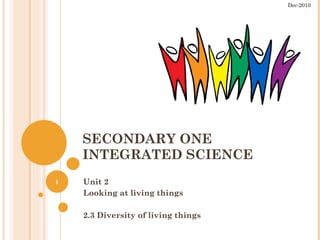S.1 Integrated Science Diversity of Living Things
- 1. SECONDARY ONE INTEGRATED SCIENCE Unit 2 Looking at living things 2.3 Diversity of living things Dec-2010
- 2. REVISION Do you remember what did we do in the last lesson? Observation of living things External features Behaviours
- 3. THE WIDE VARIETY OF LIVING THINGS How many kinds of living things can you find in this picture of showing a corner of a park?
- 4. THE WIDE VARIETY OF LIVING THINGS OK! Let me count how many living things! 5ĪŁ 10ĪŁ There are at least 10 living things just at a corner of a park! Oh! I canĪ»t imagine how many kinds of living things in the world!
- 5. THE WIDE VARIETY OF LIVING THINGS Let me tell you the answer. Scientists estimate that there are 4 million to 12 million kinds of living things on Earth.
- 6. THE WIDE VARIETY OF LIVING THINGS WOW! However, I have a question. Why is the total number of kinds of living things on Earth only an estimate?
- 7. THE WIDE VARIETY OF LIVING THINGS It is because some living things cannot be seen directly and some of them live in the deep sea or hide themselves from human. So the exact number remains unknown.
- 8. THE WIDE VARIETY OF LIVING THINGS These living things differ in : size body forms body structure
- 9. THE WIDE VARIETY OF LIVING THINGS
- 10. LIVING THINGS AND THEIR HABITATS Natural environment where living things live http://www.youtube.com/watch?v=zNTHVLxPP54 Can you point out the habitats mentioned in the video?
- 11. LIVING THINGS AND THEIR HABITATS Behaviours Body feature s help living things to adapt to their habitats
- 12. IN THE FOREST some plants climb on tree trunks reach for more sunlight
- 13. IN THE GRASSLAND antelopes run fast escape from predators
- 14. IN THE DESERT cacti store a lot of water survive in dry environment
- 15. IN THE FRESHWATER STREAM webbed feet frogs ha ve webbed feet swim in water
- 16. IN THE OCEAN dolphins ha ve a streamlined body swim with little water resistance
- 17. IN THE POLAR REGION seals ha ve a thick la y er of fat under skin keep warm in cold environment
- 18. WHAT ELSE? Hong Kong Wetland Park http://www.wetlandpark.com/en/biodiversity/hab_fm.asp
- 19. ROLE PLAY 3 students Imagine you are a specified living thing and follow the instructions below. Do the suitable action (e.g. move slowly/ voice) Say the special feature(s) you have Choose the most favourable habitat for you to live Explain your choice
- 20. 1. CAMEL (A) Grassland (B) Desert (C) Polar region
- 21. 2. PENGUIN (A) Polar region (B) Rainforest (C) River
- 22. 3. SHEEP (A) Ocean (B) Polar region (C) Grassland >
- 23. RECALLING YOUR MEMORY Worksheet of 2.2 Observing Living Things Question of finding differences between two tortoises Answers included Size Weight Pattern Colour Etc. Those differences are called variations
- 24. VARIATIONS The differences among the individuals of the same kind of living things
- 25. VARIATIONS Continuous Have a range of intermediate between two extremes. E.g. Height Discontinuous Have no intermediates. Either have the characteristic or donĪ»t. E.g. Blood type
- 26. CLASSROOM ACTIVITY 2.4 Variations within humans Can you roll your tongue? Do you have free or attached earlobes? Can you bend your thumb back? Measure your hand-span in cm. Draw a bar chart to show the distribution.
- 27. WHAT SHOULD WE LEARN FROM VARIATIONS? Not bad or good Everyone has his/ her own characteristics Respect and accept each other
- 28. SUMMARY Scientist estimate ( ╣└ėŗ ) 4 millions to 12 millions kinds of living things on Earth They are different in size, body form and body structure There are many habitats ( ╔·Š│ ) in the world where living things are living in Desert ( ╔│─« ) Ocean ( ║Żč¾ ) Forest ( ╔Ł┴ų ) Polar region ( śOĄž ) Etc. Living things adapt ( ▀mæ¬ ) the habitats by their body features and behaviours
- 29. SUMMARY Variations ( ▓Ņ«É ) exist among the individuals of the same kind of living things. Continuous variations ( ▀B└m▓Ņ«É ) Height Weight Discontinuous variations ( ▓╗▀B└m▓Ņ«É ) Skin colour Blood type We should respect ( ūųž ) and accept ( Įė╝{ ) everyone.





























